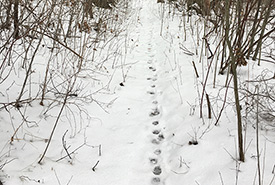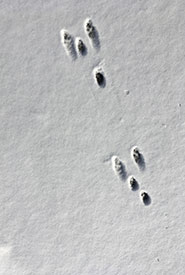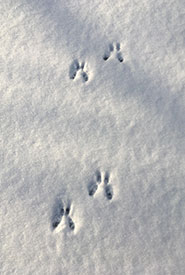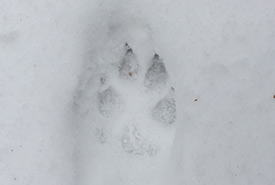How tracking animals leaves a different imprint on winter

Tracks of a coyote walking – note the straight track pattern. (Photo by NCC)
No matter where you live in Canada, temperatures have dropped and there’s most likely snow on the ground — a telltale sign that winter’s here and isn’t going anywhere for the next little while.
It isn’t a secret that most city dwellers have complicated relationships with winter (myself included). When the weather takes a turn for the worse, it seems to have a domino effect on urban centres, increasing traffic and slowing everything to a halt. I used to roll my eyes every time it started to snow, but this year I’m planning on doing things a bit differently ― with the help of some furry friends.
Use this printable guide the for your next winter animal tracking adventure.
Take this quiz to test your knowledge at the end of your read.
During my daily treks to and from work, and during my weekend hikes, I’ve started looking down and around for evidence of local wildlife ― whether through their tracks, middens (feeding evidence) or scat (that’s poop!). Turns out, I’m not alone.

Eastern cottontail tracks (Photo by Chase Wasteicoot)

Grey squirrel tracks (Photo by Chase Watesicoot)
Depending on the habitat you’re walking in, and where in Canada you are, the types of species will differ. For example, you’ll see different animal signs when walking through a forest than you would in a residential park. The most common tracks to see in both of these areas are from a rabbit, such as eastern cottontail, or a red or grey squirrel. Both species’ tracks appear a bit backwards to us two-legged, upright humans. Their bigger hind feet appear in front of their smaller, front feet. You can tell the difference between the two as squirrel prints are side-by-side (with grey squirrels being twice the size as red squirrels) and usually lead to a tree, while rabbit tracks are more staggered and roughly make the shape of a triangle.
Other signs of urban visitors you might come across are mice, voles, raccoons or opossums. Mice and voles tracks are small and even, and sometimes leave a tiny mark from their tail. In deeper snow, look for tunnels just under the surface, where these rodents find food and warmth. Raccoon and opossum tracks are my favourites, since they look like tiny hands in the snow.
If you’re really lucky, you may come across some fox or coyote prints next time you’re on a winter nature hike in the forest. Depending on the density of the snow, you may see a neatly indented paw print. If the snow is deep, it may just look like an oval-shaped print. Either way, these species tend to walk by putting one paw in front of another, creating a narrow, straight track. Unlike dog tracks, which tend to wander more, coyotes and foxes usually walk in straighter lines.

Coyote tracks (Photo by NCC)
There’s something special about seeing a wild animal in its natural environment, but seeing the signs they leave behind — but not necessarily the individual itself — is like solving a mini-mystery. I love seeing a track preserved in the snow and trying to decipher which species could have left it.
Recently, I was walking my dogs and found a pristine track along my driveway. It seems as if an eastern cottontail had made its way along my walking route, almost walking paw in foot with me. I looked around to see if I could spot it, but, alas, it was gone.
As a former winter-whiner (definition: an individual who complains about winter weather conditions non-stop), I’m learning to embrace the white, fluffy stuff, and tolerate the fact that for most of the time between December and March, I can’t feel my face. Through visiting a Nature Conservancy of Canada property, such as Happy Valley Forest, I can look for evidence of my favourite animal frolicking about and know that the one thing that makes someone truly Canadian is braving the cold.



